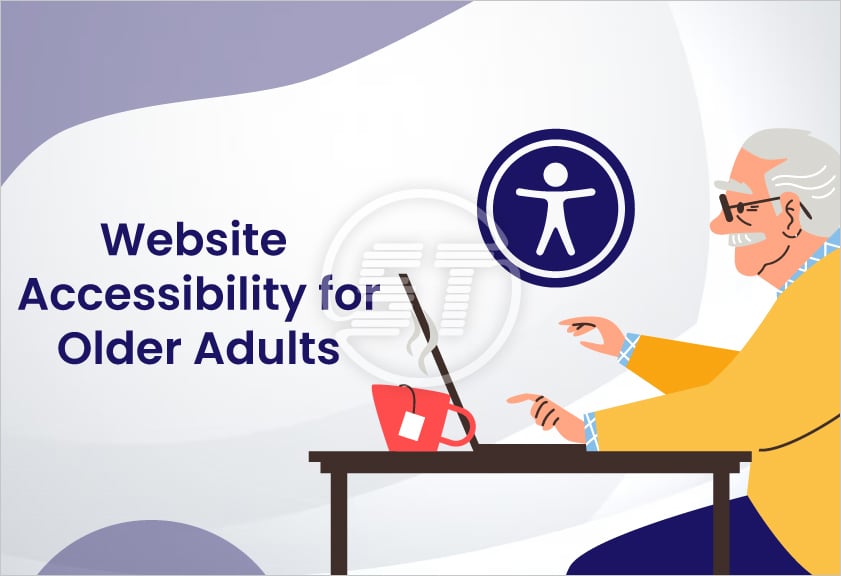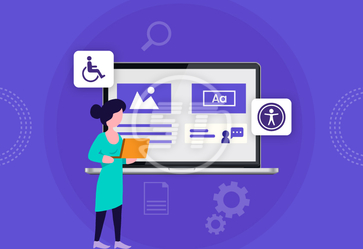Inclusive websites imply such web designs that are accessible to every user seeking to explore a website including older adults. Designing websites keeping older people in mind is important because with age, several limitations get imposed on the human body that need to be addressed. They may face low vision, hearing issues, less understanding of new slang, and many more other problems.
Therefore, considering their unique needs and including them in the design and development of websites and applications is crucial. Let’s understand what can be done to offer a smooth user experience to older adults.
Key strategies for inclusive web design
Assistance or guidance
Often younger people are more technology savvy whereas older adults encounter trouble understanding new technologies. Thus, it is useful to provide onboarding guidance on how to use the website or app by explaining features or giving a tooltip walkthrough orientation.
If a user gets lost somewhere within the site, there must be some easy way for them to find help. It can be a FAQ section, contact support, or a link to documentation. Ensure that the assistance is accessible. It will also reduce the bounce rate or cart abandonment rate.
Lesser distracting elements
Not all older adults develop issues related to memory, but it is wise to keep web design simpler. Thereby they don’t get distracted or require remembering multiple things. Including familiar icons or colors to represent specific features or actions are useful.
People with memory issues require continuous assistance to complete their actions. To help such users, success and error toast messages and progress bars can be added to web design. Nudging them regularly to remind about their task and providing tips to complete them is a good way to complete their tasks.
Designs for low vision
Several older adults develop low vision or other vision-related issues such as night blindness, blurred vision, etc. This is a common problem with age and not only older people, but young ones also go through different issues with vision.
Web designs must cater to older adults to own an accessible interface. It means the text size should be min 16px or there should be a text adjustment option. Use larger fonts like sans-serif font to enhance readability.
Moreover, color contrast between text and its background ought to be 4.5:1 to make sure people can read the content or identify the object clearly. Also, avoid using color alone to convey information.
Make sure the website is responsive and works well on various devices, including tablets and smartphones.
Simplified navigation
Older adults also decline their cognition, which becomes a hindrance in their process of understanding things. Thus, avoiding complex navigation reduces cognitive overload on them. Web design with a back button on every page, including visuals in the navigation menu, or leading users through a wizard is required.
Use a straightforward layout with intuitive navigation. Limit the number of menu items and use clear, descriptive labels.
Maintain consistency in design elements and layout across all pages to reduce confusion.
Implement breadcrumb navigation to help older adults understand their location within the site.
Assistive technologies compatibility
Ensure compatibility with screen readers by using proper HTML semantics and providing alternative text for images.
Design a website in such a way that it can be fully navigated using a keyboard, catering to some of the older adults facing difficulty using a mouse.
Content considerations
Write in clear, simple language. Avoid jargon and overly complex sentences.
Provide captions for videos and transcripts for audio content. Ensure images have descriptive alt text.
Use clear and concise error messages with suggestions for correction.
User testing with older adults
Involve older adults in the design process through user testing and feedback sessions.
Use their feedback to make iterative improvements, ensuring the website meets their needs and preferences.
Benefits of Inclusive Web Designs
Organization reaches to older users
An inclusive website fulfils the requirements of older adults along with all other users, which ultimately enhances the reach of the website to a wider segment of older people.
Improved usability for all
Designing for older adults often leads to improved usability for all users. Clear navigation, accessible content, document accessibility, etc. benefit everyone, not just people with specific needs.
Enhanced brand loyalty
Demonstrating a commitment to accessibility can enhance brand reputation and foster loyalty among users.
Wrapping up
Creating an inclusive website experience for older adults requires thoughtful consideration of their unique challenges and proactive implementation of accessibility features. By adopting accessible design principles, organizations can ensure that their websites are accessible to all users, fostering a more inclusive digital world.
Create an accessible, inclusive, user-friendly, and barrier-free website for deaf or users with hearing impairment. At Skynet Technologies, we are providing complete digital accessibility solution including accessibility audit, remediation, document accessibility, training, ongoing monitoring, and support to make and improve website accessibility. We offer AI-based All in One Accessibility widget, is a simple, quick, and cost-effective accessibility solution including Elderly profile contains features like content scaling, text magnifier, stop animations, reading guide, smart contrast, highlight focus, and more.
Let's make your website or web app accessible for everyone, so that every user can engage in a seamless way. For more information, reach out us to [email protected].


